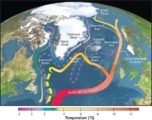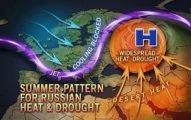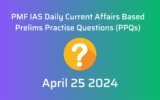
Russia – Ukraine Crisis
Subscribe to Never Miss an Important Update! Assured Discounts on New Products!
Must Join PMF IAS Telegram Channel & PMF IAS History Telegram Channel
Russia – Ukraine Crisis
- Ukraine & Russia were a part of the USSR and share hundreds of years of cultural, linguistic & familial links.
- Among the former USSR nations, Ukraine was the 2nd most powerful nation after Russia.
- The relations between the two nations were cordial from the dissolution of the USSR up until recently.
- Tensions between the two nations began in late 2013 over Ukraine’s landmark political & trade deal with the European Union.
Euromaidan Movement
- Majority of the Ukrainians were angry with the then pro-Russia President Viktor Yanukovych’s decision to join the Russia-led Eurasian Economic Union instead of the EU. Their protests were known as the Euromaidan movement.
- It saw massive clashes between the protesters and security forces that reached their peak in 2014 and led to the ouster of Yanukovych.
- Soon after, amid fears of growing Western influence in Ukraine, Russia decided to act by invading Crimea, which was a part of Ukraine.
- Thereafter, Russia faced sanctions from the west owing to its action of invading Crimea.
What is the Current Issue?
- Russia was keeping the tensions high at the Ukraine border in order to get sanctions relief & other concessions from the West.
- Also, it was seeking assurances from the US that Ukraine will not be inducted into NATO.
- However, the failure of such assurance by the west, & the pro-outlook of Ukraine towards the west & NATO, gave an excuse to Russia to conduct a special military operation on Ukraine on the pretext of “demilitarization and denazification” of Ukraine.
Causes Behind the Deepening Crisis
Expansions Carried out by NATO
- Even as the Soviet Union was dissolved NATO embarked on a path of expansion. It started to pull former Warsaw Pact states into its membership.
- Both for Russia & for the West, Ukraine acted as a crucial buffer at times of war or uncertainty. With Ukraine seeking NATO membership, this safe buffer for Russia was fast disappearing.
Balance of Power
- Ever since Ukraine split from the Soviet Union, both Russia and the West have vied for greater influence in the country in order to keep the balance of power in the region in their favour.
Russia’s Strategic Disadvantage Due to Geography
- Russia-Ukraine Crisis is also a fight to overcome geographical disadvantages faced by Russia.
- In the event of a war, the Russian navy cannot get out to the Baltic Sea either because NATO controls the Skagerrak Strait, which connects to the North Strait.
- If Russia gets past the Skagerrak, the GIUK Gap (Greenland, Iceland, UK) in the North Sea will prevent its advance to the Atlantic.
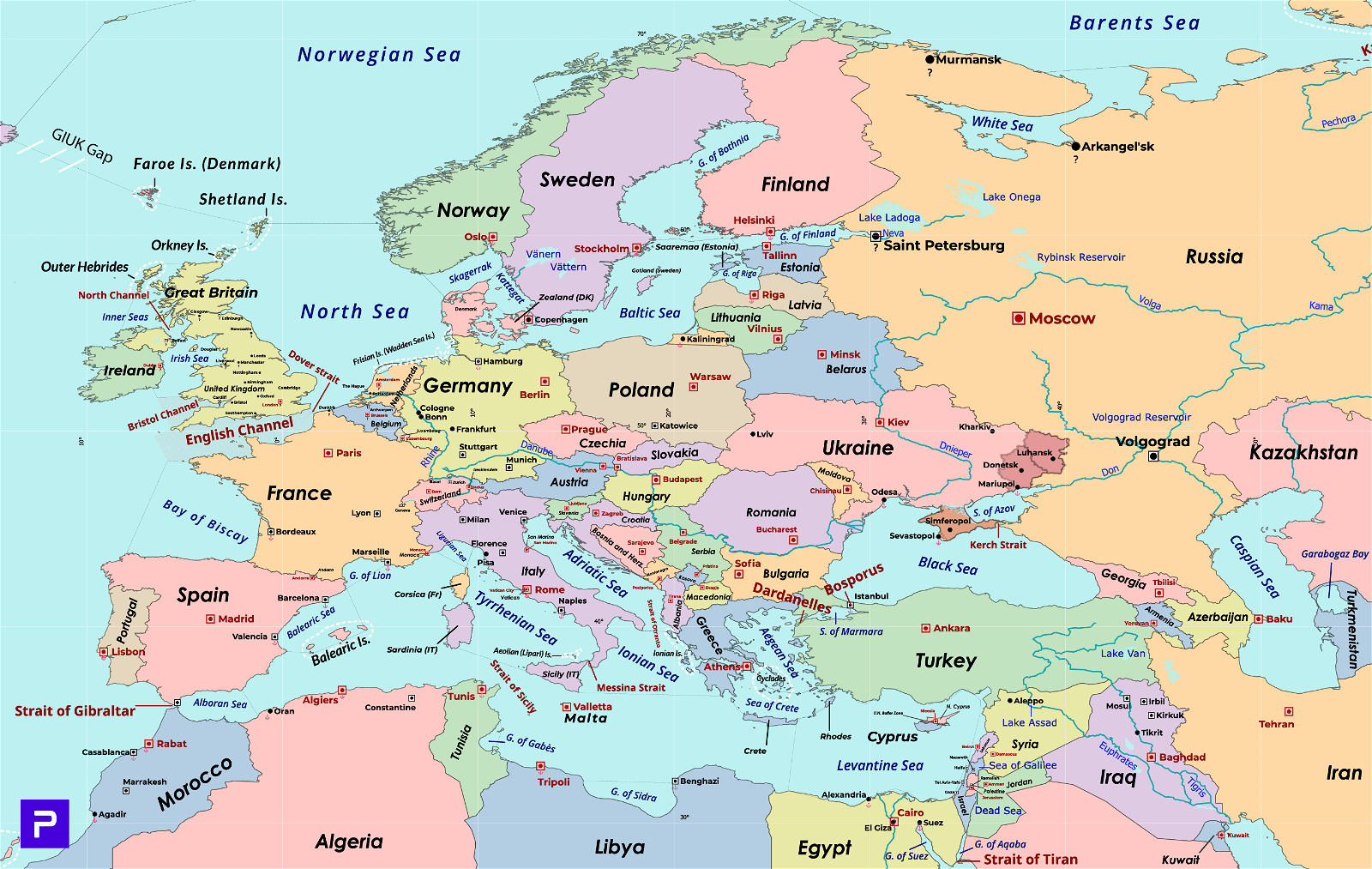
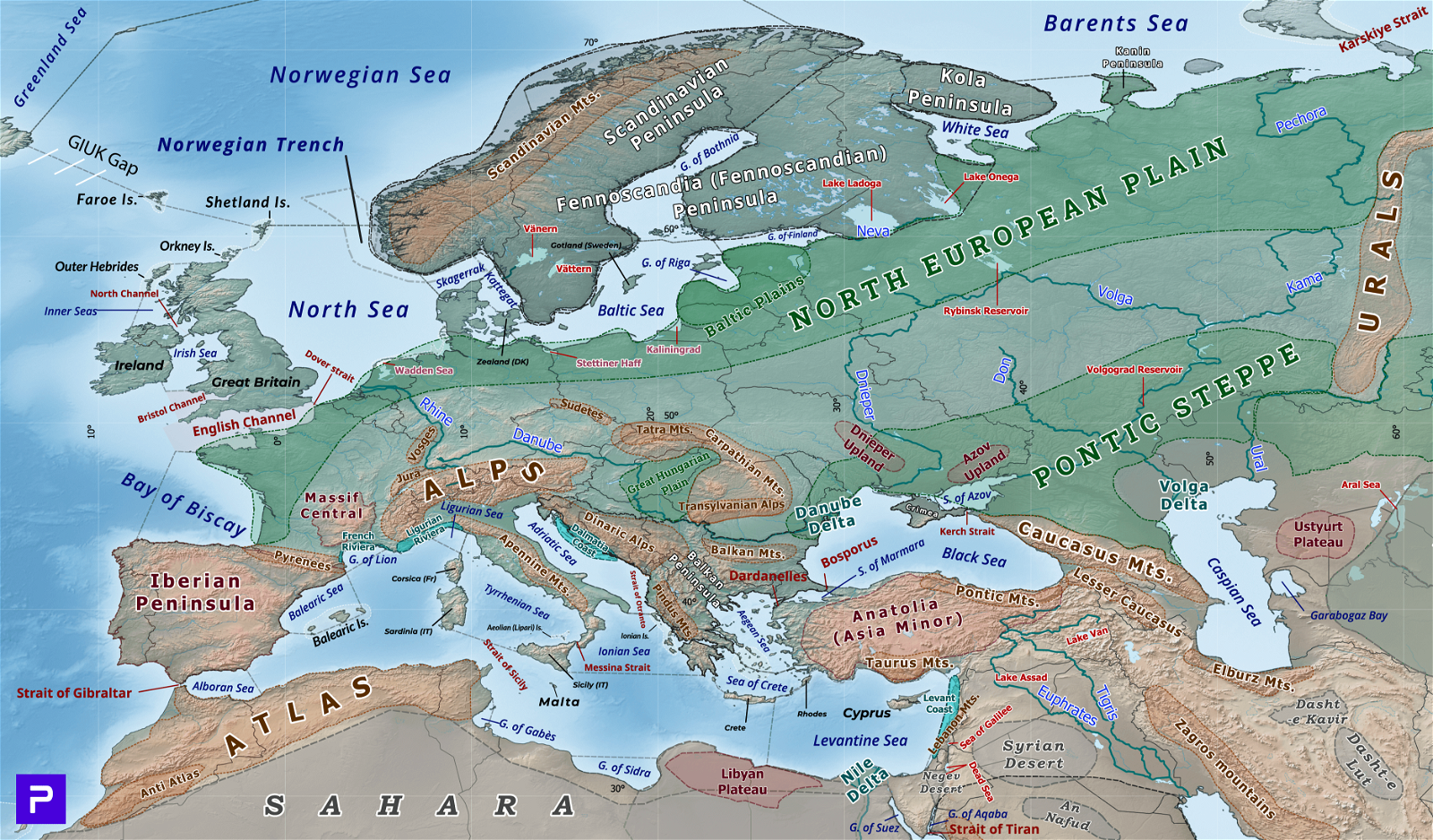
- Beyond Bosporus, the Aegean Sea, Mediterranean & Gibraltar Straits impede Russia’s movement to the Atlantic Ocean or its route to the Indian Ocean via the Suez Canal.
- Its naval facility in the Syrian coastal city of Tartus is strategic but limited.
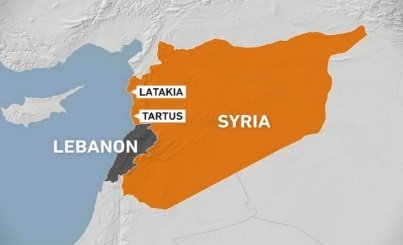
Russia’s Demands
- Russia has demanded a ban on further expansion of NATO that includes countries like Ukraine and Georgia that share Russia’s borders.
- Russia asked NATO to pull back its military deployments to the 1990s level and prohibit the deployment of intermediate-range missiles in the bordering areas.
- Further, Russia has demanded NATO to curb its military cooperation with former Soviet republics including Ukraine.
Response from the West
- The U.S. has ruled out changing NATO’s “open-door policy” which means, NATO would continue to induct more members.
- The U.S. also says it would continue to offer training and weapons to Ukraine.
- The U.S. & West are imposing new economic sanctions on Russia.
Way Forward: Minsk Agreements
- A practical solution for the Russia-Ukraine situation is to revive the Minsk peace process.
- Minsk agreements were signed to stop the ongoing conflict between pro-Russian separatists & Ukraine administration in the mineral-rich Donbas region of Ukraine.
Minsk I
- Ukraine and the Russian-backed separatists agreed a 12-point ceasefire deal in the capital of Belarus in 2014.
- Its provisions included:
- prisoner exchanges,
- deliveries of humanitarian aid and
- the withdrawal of heavy weapons
- The agreement quickly broke down, with violations by both sides.
Minsk II
- In 2015, an open conflict was averted after the ‘Minsk II’ peace agreement was signed, under the mediation of France and Germany.
- Representatives of Russia, Ukraine, the Organisation for Security and Cooperation in Europe (OSCE) and the leaders of two pro-Russian separatist regions signed a 13-point agreement.
- The five most important of the 13 points were, in brief:
- An immediate and comprehensive ceasefire
- Withdrawal of all heavy weapons by both sides
- Restore full control of the state border by the government of Ukraine.
- Withdrawal of all foreign armed formations, military equipment and mercenaries.
- Constitutional reform in Ukraine including decentralisation, with specific mention of Donetsk and Luhansk (paving the way for their secession from Ukraine!).
Strategic Regions
Crimea
- In 2014, Russia invaded and subsequently annexed the pro-Russian Crimean Peninsula from Ukraine.
Why is Crimea so important for Russia?
- Vladivostok, the largest Russian port on the Pacific Ocean, is enclosed by the Sea of Japan, which is dominated by the Japanese.
- This does not just halt the flow of trade into and out of Russia; it prevents the Russian fleet from operating as a global power, as it does not have year-round access to the world’s most important sea lanes.
- Moreover, most of the Russian ports, even when open for business, do not allow for easy access to the Mediterranean Sea.
- This has left Russia with a commercial and military incentive to expand in warmer water. Hence, the port in Crimea.
Sevastopol Port
- Warm-water ports are important to Russian security because they enable Russia to control the sea, project power, maintain good order, and observe a maritime consensus.
- The Port of Sevastopol is considered a key hold for maritime routes between the Black Sea & Sea of Marmara, and, therefore, the Mediterranean Sea and the Atlantic Ocean.
- The port is one of the few warm deep-water ports available to Russia in the Black Sea.
- Also, the Russian Black Sea Fleet is situated in Sevastopol & its presence in the area gives Russia a military advantage and it can carry out tactical manoeuvres (as it did in the Georgian-Russian conflict).
- Its importance has grown since the Syrian conflict because losing the Tartus fleet in Syria would mean having only one warm-water port in Sevastopol.
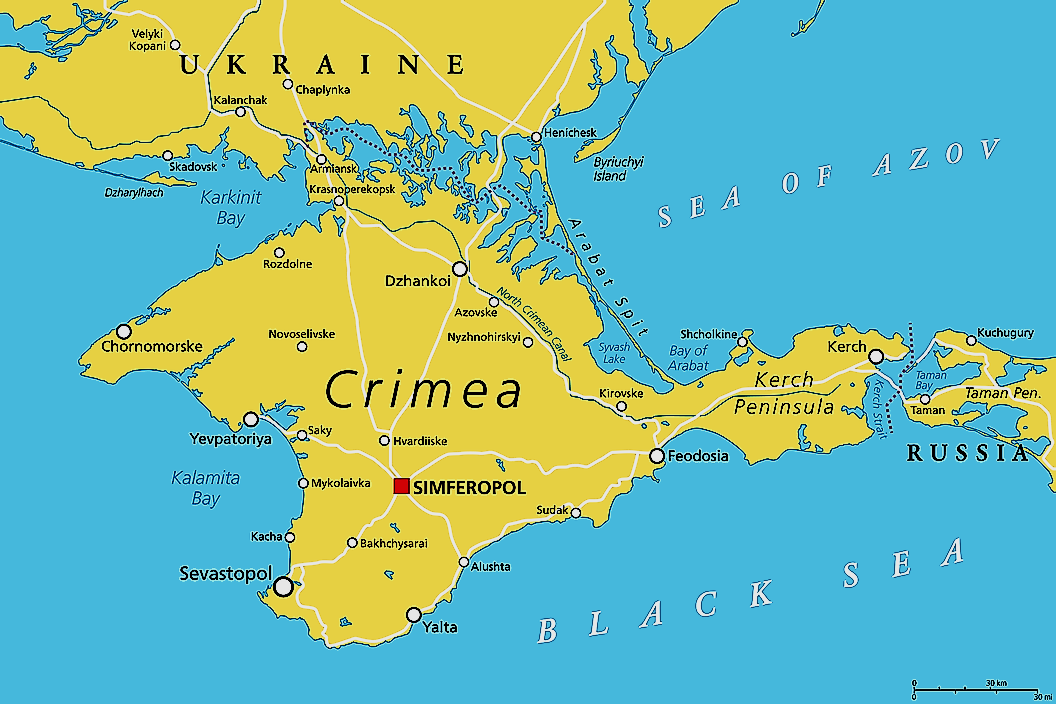
Donbass Region
- Russia officially announced independence of the Donetsk and Luhansk republics effectively killing the Minsk agreements. Both Donetsk and Luhansk are collectively called as Donbas Region.
Significance of Region
- It is important to Russia’s current vision for Ukraine, as it contains areas controlled by Russian-backed separatist groups. Also resource wise, Donbass region is rich in coal.
NORD Stream 1 & NORD STREAM 2
- Nord Stream is a set of offshore natural gas pipelines in Europe, running under the Baltic Sea from Russia to Germany.
-
It includes 2 projects:
- Nord Stream 1: Running from Vyborg in northwestern Russia near Finland
- Nord Stream 2: Running from Ust-Luga in northwestern Russia near Estonia.
Who is against Nord Stream 2?
- The US and UK, along with Russia’s neighbours Poland and Ukraine, strongly oppose Nord Stream 2.
- They fear that if were to start operating, it would give Russia even more of a stranglehold over gas supplies to Europe.
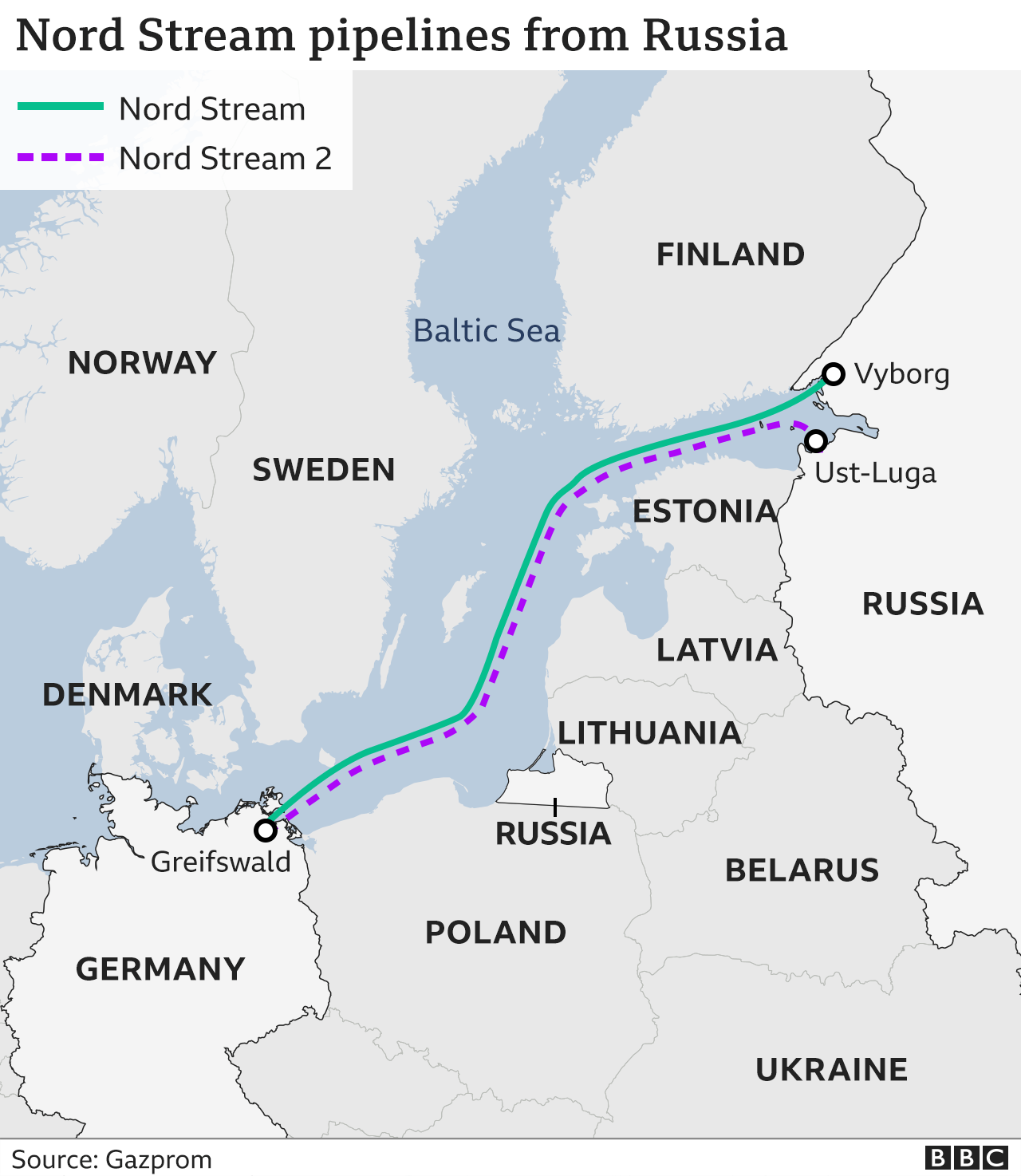
Effect of Russia – Ukraine Crisis on Global Supply Chain
- Russia-Ukraine crisis will affect the Global Supply Chain in near future. Shortages & price increases of goods & services will eventually impact countries & could stoke social unrest.
Disrupted Ukraine Exports
- Ukraine is long known as the breadbasket of Europe. Ukraine has high quality soil on its eastern, south-eastern part, which made Ukraine the largest crop producing country in Europe.
- It accounts for more than 25% of the world’s trade in wheat and for more than 60% of global sunflower oil & 30% of global barley exports.
- It sends more than 40% of its wheat & corn exports to the Middle East or Africa.
- Some 45%-54% of the world’s semiconductor grade neon, critical for the lasers used to make chips, come from the Ukrainian firms, which are now shut following the attack by Russia. The stoppage casts a cloud over the worldwide output of chips already in short supply after the coronavirus pandemic.
Disrupted Russian Exports
- Russia is the world’s largest supplier of wheat.
- Russia is also a major global exporter of fertilizers.
- Europe gets nearly 40% of its natural gas & 25% of its oil from Russia.
- Russia is a significant source of many of the 35 critical minerals deemed vital to the nation’s economic and national security interests, including 30% of the globe’s supply of platinum-group elements, 13% of titanium & 11% of nickel.
- Russia is also a major source of neon, used for etching circuits on silicon wafers.
- Russia exports rare metals like palladium to make semiconductors.
What is Palladium?
|
Important Geographical Locations / Places / Features in News
Ukraine
- It is a country in Eastern Europe.
- Ukraine share borders with:
- Belarus to the north
- Russia to the east
- Sea of Azov & Black Sea to the south
- Moldova & Romania to the southwest
- Hungary, Slovakia & Poland to the west
- The capital is Kyiv (Kiev), located on the Dnieper River.
- The most notable rivers of Ukraine include the Dnieper, Dniester, Southern Buh & Siversky Donets.
- Most of the rivers of Ukraine drain into the Black Sea & Azov Sea that belong to the bigger Mediterranean basin (flow in a southerly direction).
- Important Cities: Kyiv, Kharkiv, Odessa, Donbass Region, Mykolaiv, Mariupol, Simferopol, etc.
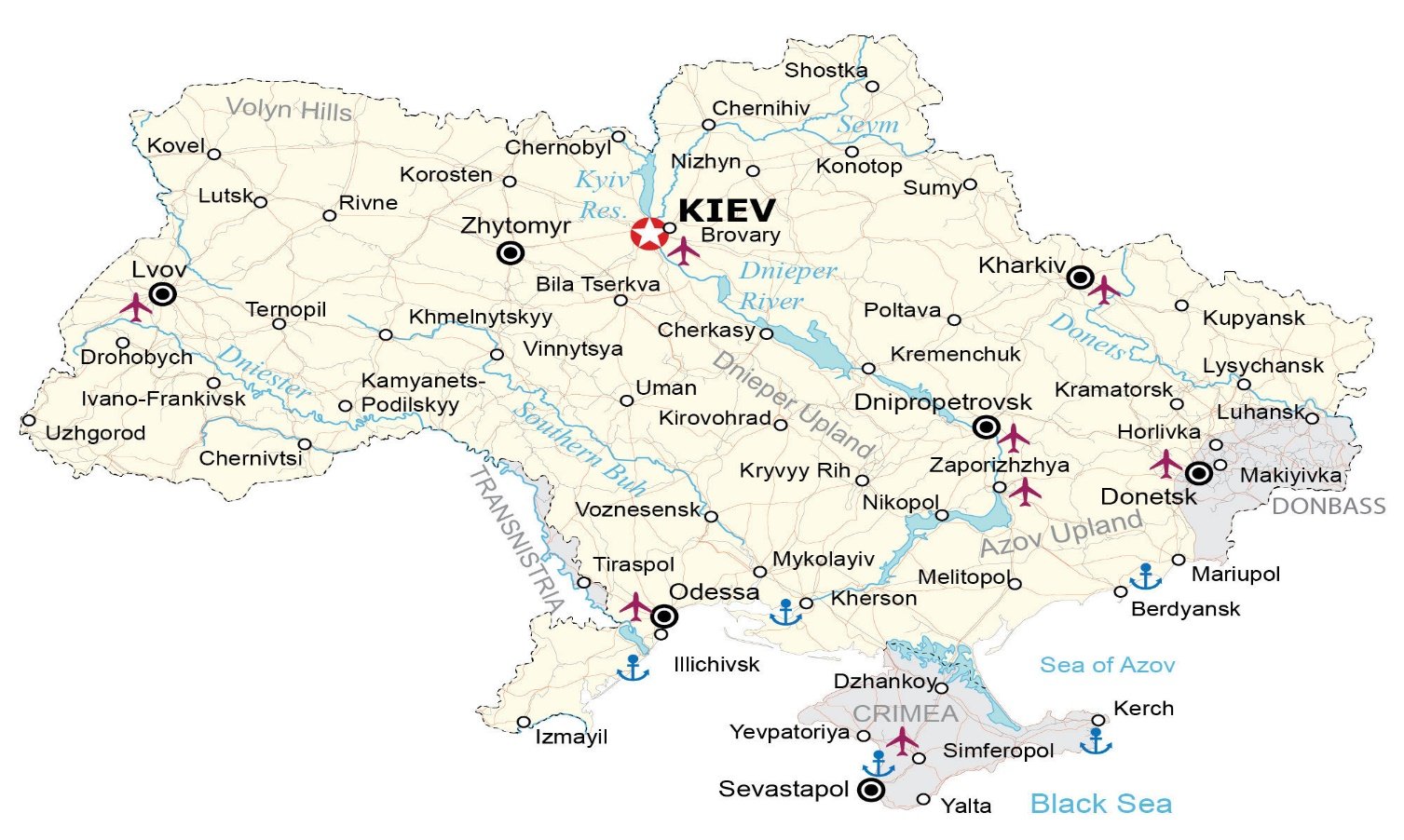
Sea of Azov
- It is a sea in Eastern Europe connected to the Black Sea by the narrow Strait of Kerch.
- It is sometimes regarded as a northern extension of the Black Sea.
-
The sea is bounded by:
- Russia on the southeast
- Ukraine on the northwest
- The main rivers flowing into it are the Don & Kuban.
- The Sea of Azov is an internal sea with passage to the Atlantic Ocean going through the Black, Marmara, Aegean and Mediterranean seas.
- The narrowness of the Kerch Strait limits the water exchange with the Black Sea. As a result, the salinity of the Sea of Azov is low.
- Many rivers flowing into the Sea of Azov form bays, lagoons and limans.
- The sand, silt and shells they bring are deposited in the areas of reduced flow, that is the sides of the bays, forming narrow sandbanks called “spits”.
- Ports located along the Sea of Azov are Berdyansk, Mariupol, Taganrog & Yeysk.
Black Sea
- Black Sea is a marginal Mediterranean Sea of the Atlantic Ocean lying between Europe and Asia
-
It lies:
- East of the Balkan Peninsula (Southeast Europe)
- South of the East European Plain in Eastern Europe
- West of the Caucasus
- North of Anatolia in Western Asia.
- It is supplied by major rivers principally the Danube, Dnieper & Don.
- Major mountain ranges: Pontic Mountains (South), Caucasus Mountain (East) & Crimean Mountains (North).
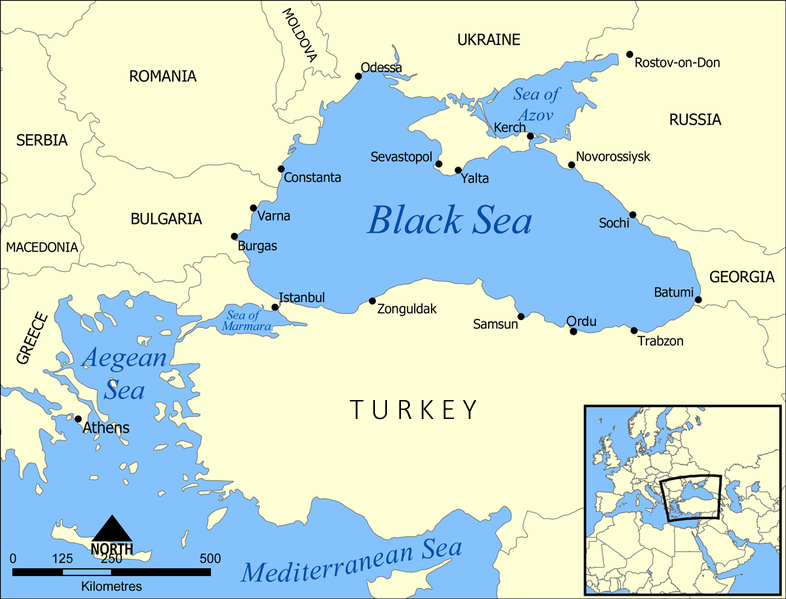
- Important cities along the coast include Istanbul, Odessa, Varna, Samsun, Sochi, Sevastopol, Constanța, Trabzon, Novorossiysk, Burgas, Batumi, etc.
-
Countries bordering Black Sea:
- Bulgaria
- Georgia
- Romania
- Russia
- Turkey
- Ukraine
- It ultimately drains into the Mediterranean Sea, via the Turkish Straits & the Aegean Sea.
- The Bosporus Strait connects it to the small Sea of Marmara which in turn is connected to the Aegean Sea via the Strait of the Dardanelles.
- To the north, the Black Sea is connected to the Sea of Azov by the Kerch Strait.
- There is a significant absence of oxygen in the water.
Turkish Straits
- The straits create a series of passages that connect the Aegean and Mediterranean seas to the Black Sea.
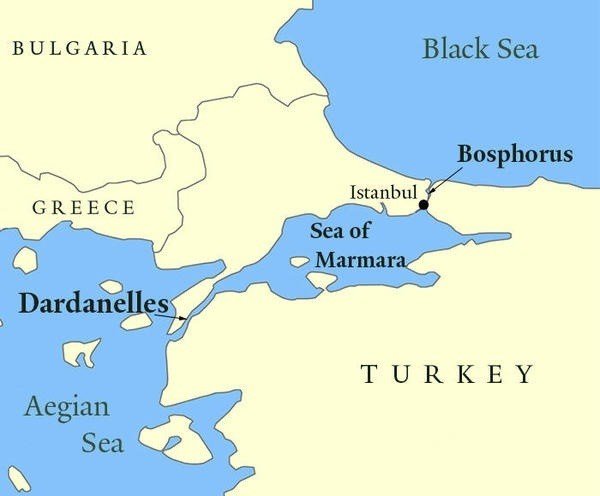
Montreaux Convention
- According to the 1936 Montreux Convention, Turkey has control over both the Bosporus & Dardanelles straits (Turkish Straits).
- In the event of a war, the pact gives Ankara the right to regulate the transit of naval warships and to block the straits to warships belonging to the countries involved in the conflict.
Sea of Marmara
- The Sea of Marmara is an inland sea separating Asiatic & European parts of Turkey.
- It serves as a transitional zone between the Black Sea & the Mediterranean Sea.
- It is connected through:
- Bosporus Strait on the northeast with Black Sea
- Dardanelles on the southwest with the Aegean Sea.
- Bosphorus, the Dardanelles Straits and the Sea of Marmara forms a part of the Turkish Straits System.
- North Anatolian Fault which runs beneath the sea has caused several massive earthquakes in the region.
- It serves as an important navigational waterway for the transportation of petroleum & natural gas to Europe from the western part of Asia & Russia.
- Some of the important coastal towns & cities that are located along the Sea of Marmara include Istanbul, Izmit, Balikesir, Yalova, Tekirdag, Bursa, & Çanakkale.
- Marmara Island is Turkey’s second-largest island as well as the largest island in the Marmara Sea. It is also a rich source of marble.
Caspian Sea
- The Caspian Sea is the world’s largest inland body of water.
- The Caspian Sea, like the Black Sea, is a remnant of the ancient Paratethys Sea.
- The Caspian Sea is highly-prized for its vast oil & gas reserves
- Countries Bordering: It is bounded by Kazakhstan, Russia, Azerbaijan, Iran & Turkmenistan.
- Its main freshwater inflow comes from Europe’s longest river, the Volga, and the Ural River.
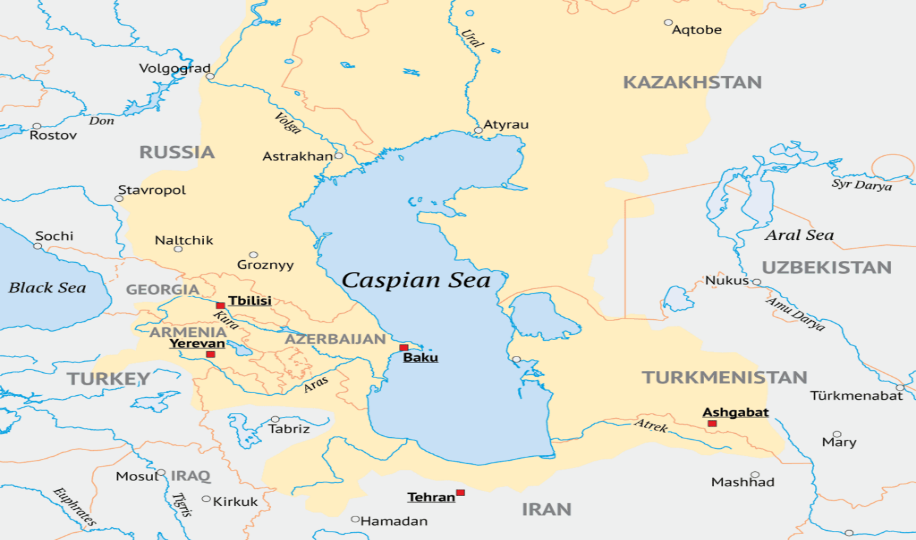
Baltic states (Baltics, Baltic nations)
- Baltics is a geopolitical term, typically used to group the 3 countries on the eastern coast of the Baltic Sea: Estonia, Latvia & Lithuania.
- The three countries do not form an official union but cooperate in the matters of security & defence.
- All 3 countries are members of NATO (to counter the bullying by Russia), the eurozone, the OECD, and the European Union.
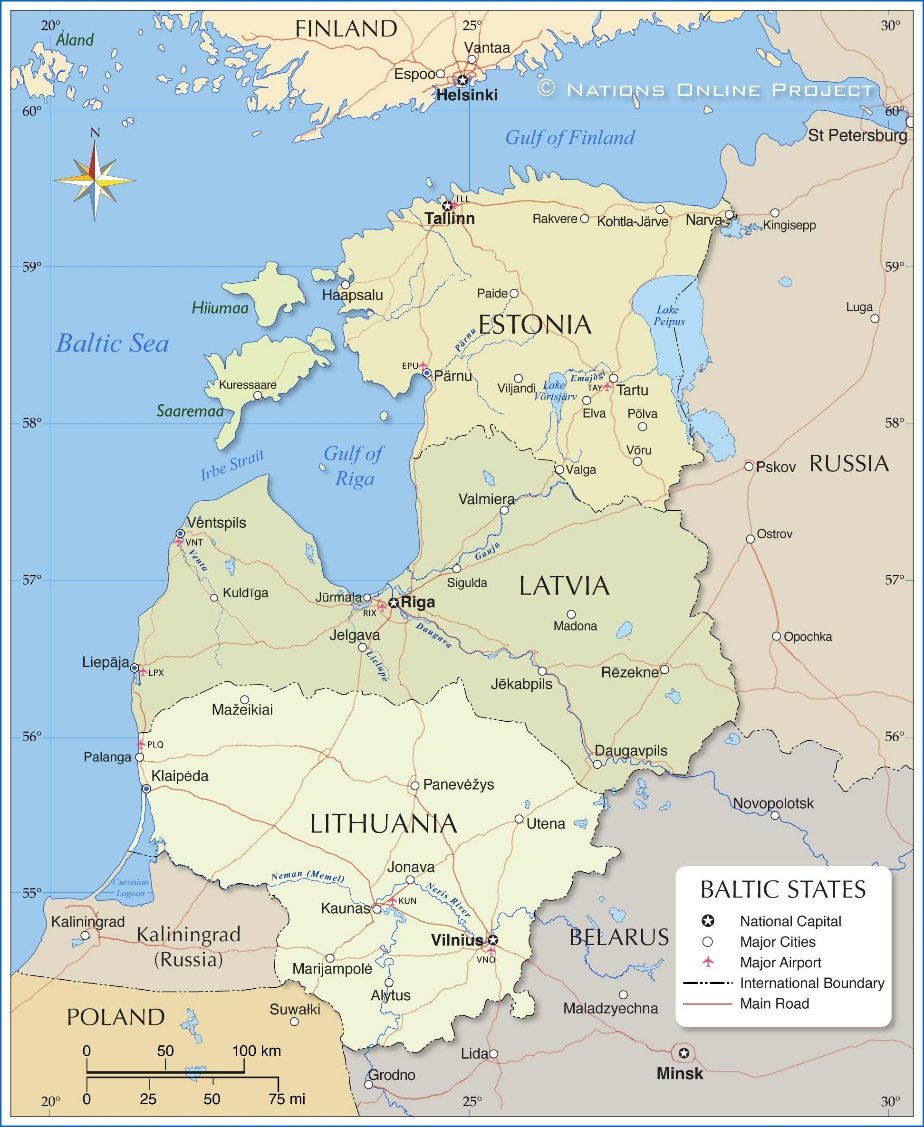
Chernobyl Nuclear Plant
- It is a closed nuclear power plant located near the abandoned city of Pripyat in northern Ukraine.
- The plant experienced a nuclear accident that occurred on 26 April 1986.
- The explosion and fire at the Chernobyl No. 4 reactor contaminated the soil, water and atmosphere with radioactive material equivalent to that of 20 times the atomic bombings of Hiroshima and Nagasaki.
Red Forests in Ukrain
- The Red Forest is the 10 sq.km area surrounding the Chernobyl Nuclear Power Plant.
- The name “Red Forest” comes from the ginger-brown colour of the pine trees after they died following the absorption of high levels of radiation from the Chernobyl accident.
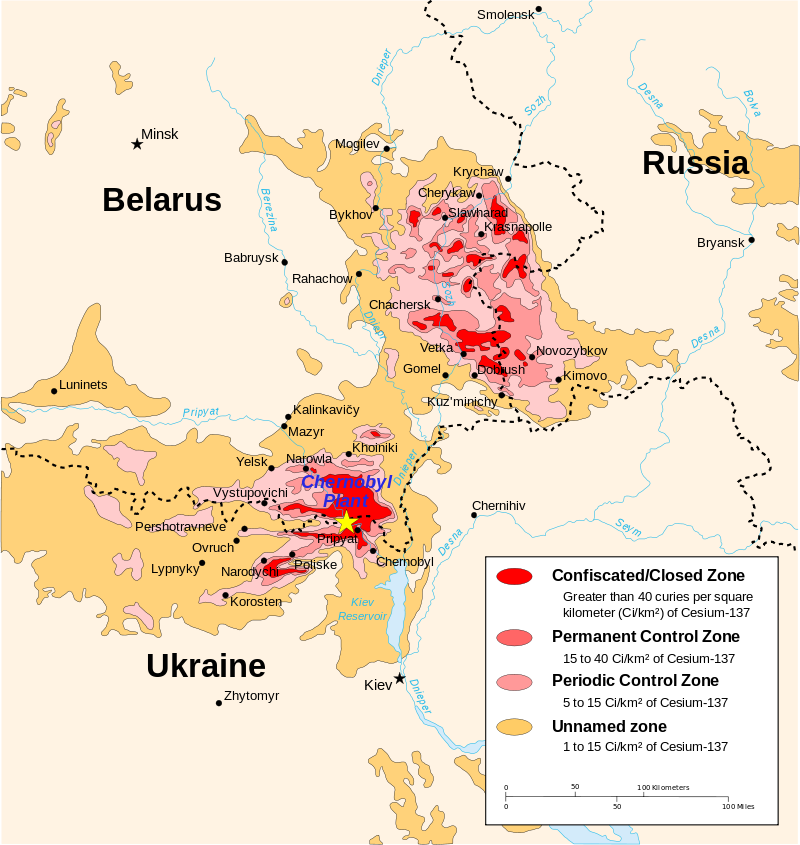
Some International Organisations in News
NATO
- It is an intergovernmental military alliance among 28 European and 2 North American countries.
- It was established in the aftermath of World War II in 1949.
- Headquarters: Brussels, Belgium.
- NATO constitutes a system of collective security, whereby its independent member states agree to mutual defence in response to an attack by any external party.
- Since its founding, the admission of new member states has increased the alliance from the original 12 countries to 30.
- The Partnership for Peace (PfP) is a NATO program aimed at creating trust between NATO and other states in Europe and the former Soviet Union.
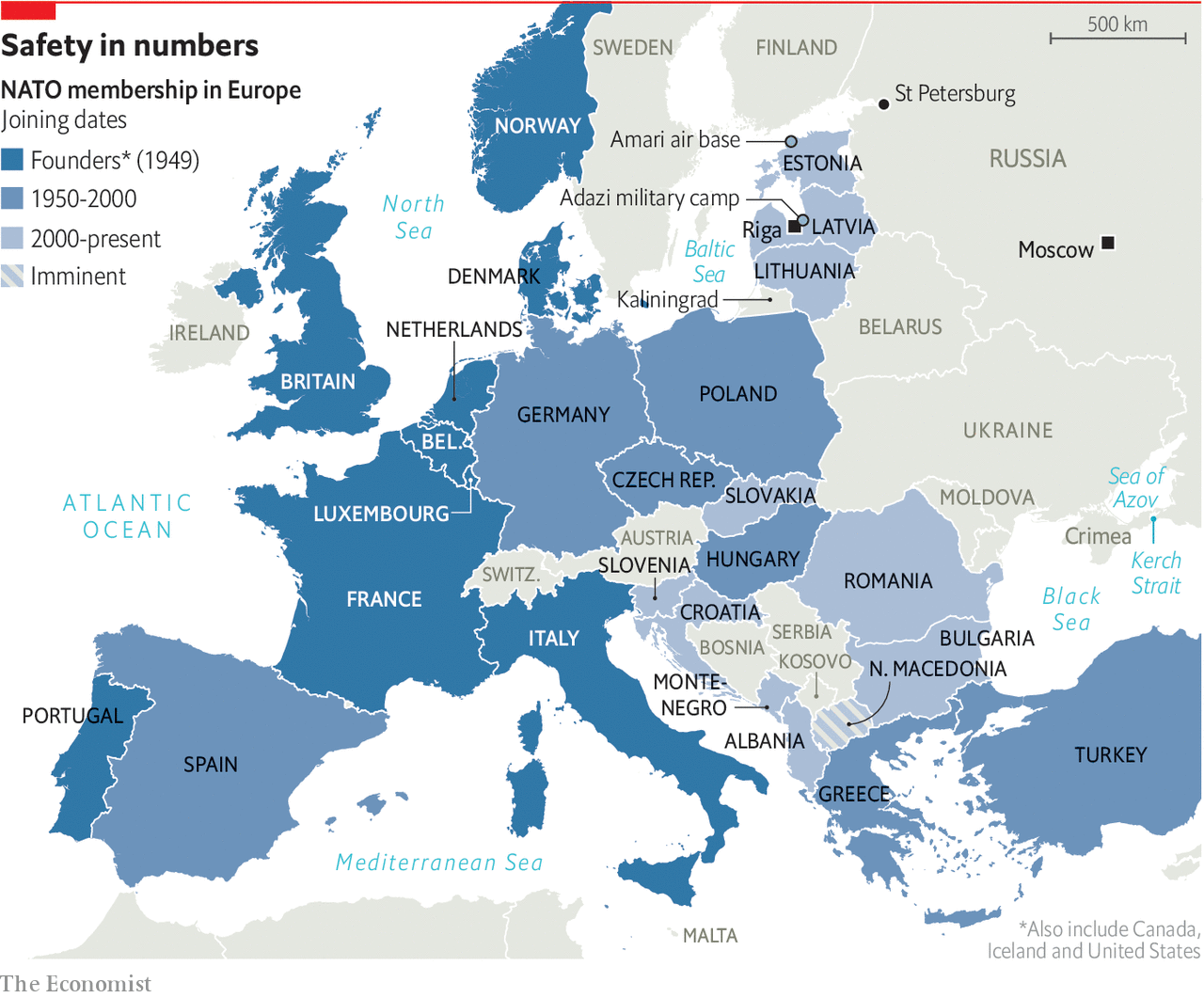
Warsaw Pact
- Warsaw Treaty or Treaty of Friendship, Cooperation and Mutual Assistance, commonly known as the Warsaw Pact (WP) was a collective defence treaty signed in Warsaw, Poland.
- It was signed between the Soviet Union and seven other Eastern Bloc socialist republics of Central and Eastern Europe.
- In was formed in 1956 in response to NATO.
- It lost its existence after USSR disintegration.
European Union (EU)
- The EU was established when the Maastricht (Netherlands) Treaty came into force in 1993.
- The EU traces its origins to the
- European Coal and Steel Community (ECSC), established by the 1951 Treaty of Paris,
- European Economic Community (EEC), established by the 1957 Treaty of Rome
- The European Union (EU) is a political and economic union of 27 member states.
- Its members have a combined area of 4.2 million km2 and an estimated total population of about 44.7 crores.
- The EU has developed an internal single market through a standardised system of laws that apply in all member states in those matters where members have agreed to act as one.
- EU policies aim to ensure the
- free movement of people, goods, services and capital within the internal market;
- enact legislation in justice and home affairs; and
- maintain common policies on trade, agriculture, fisheries and regional development.
- Passport controls have been abolished for travel within the Schengen Area.
Members
- The original members: Belgium, France, Italy, Luxembourg, the Netherlands, and West Germany.
- Members that have adopted the Euro: Austria, Belgium, Cyprus, Estonia, Finland, France, Germany, Greece, Ireland, Italy, Latvia, Lithuania, Luxembourg, Malta, Netherlands, Portugal, Slovakia, Slovenia & Spain.
- Members that have not adopted the Euro: Hungary, Czech Republic, Sweden, Denmark, Croatia, Romania & Bulgaria.

- On 31 January 2020, the United Kingdom became the first member state to leave the EU.
- Earlier, French Algeria (Colonial Algeria), Greenland (Denmark) & Saint Barthélemy (French Overseas Territory in the Lesser Antilles) — had left the EU.
- The only member state of the EU which is wholly outside of Europe is Cyprus, which is in Asia.
Eurasian Economic Union
- It is an economic union of post-Soviet states located in Eastern Europe, Western Asia and Central Asia.
- Treaty was signed in 2014 by the leaders of Belarus, Kazakhstan, and Russia, and came into force in 2015.
- The EAEU encourages the free movement of goods and services and provides for common policies in the macroeconomic sphere, transport, industry and agriculture, etc.
Organization for Security & Co-Operation in Europe
- It is the world’s largest security-oriented intergovernmental organization with observer status at the United Nations.
- It is based in Vienna, Austria.
- It has 57 members spanning Europe, Asia, and North America.
- India is not a member.
- Decisions are made by consensus.
- Its mandate includes issues such as arms control, promotion of human rights, freedom of the press, and fair elections.
- It has its origins in the mid-1975 Conference on Security and Co-operation in Europe (CSCE) held in Helsinki, Finland. In 1994, CSCE was renamed the OSCE.
Normady Format of Dialogue
- Context: Amid mounting tensions with Moscow, senior diplomats from France, Germany, Russia, and Ukraine met in Berlin in the so-called Normandy format.
- The Normandy format is a diplomatic grouping created in 2014 with the aim of finding a peaceful resolution to the conflict following Russia’s military aggression.
- The Normandy Format talks involve 4 countries:
- Germany
- Russia
- Ukraine
- France
QUAD
- The Quadrilateral Security Dialogue (QSD) is a strategic security dialogue between Australia, India, Japan, and United States that is maintained by talks between member countries.
- The dialogue was initiated in 2007 by Japanese PM.
- The dialogue was paralleled by joint military exercises, titled Exercise Malabar.
- The diplomatic and military arrangement is widely viewed as a response to increased Chinese economic and military power. Therefore, called by some as “Asian NATO”.
- During the 2017 ASEAN Summits in Manila, all four former members agreed to revive the quadrilateral alliance in order to counter China militarily and diplomatically in the “Indo-Pacific” region, particularly in South China Sea.
- Quad Plus Members: New Zealand, South Korea & Vietnam (Meeting on COVID-19 Approach).
Bucharest Nine (B9)
- The Bucharest Nine or Bucharest Format was formed in 2015 in Romania.
- It is a group of 9 NATO countries in Eastern Europe that became part of the US-led military alliance after the end of the Cold War.
- Members: Bulgaria, the Czech Republic, Estonia, Hungary, Latvia, Lithuania, Poland, Romania, and Slovakia.
- All members of the B9 are part of the European Union (EU) and NATO.
- It is also regarded as the “voice of the Eastern Flank” in the NATO alliance.
Three Seas Initiative
- The Three Seas Initiative (3SI) is a regular cooperation format that brings together 12 European Union member states between the Adriatic Sea, the Baltic Sea and the Black Sea.
- Members: Austria, Bulgaria, Estonia, Croatia, Lithuania, Latvia, Poland, Romania, Slovakia, Slovenia, the Czech Republic and Hungary.
- The partners of the 3SI are the United States, Germany and the European Commission.
- The initiative is designed to promote cooperation in order to contribute to economic growth and energy security, as well as to boost cohesion and unity in Europe.

SWIFT
- SWIFT stands for The Society for Worldwide Interbank Financial Telecommunication.
- It is a Belgian cooperative society (not intergovernmental organisation) providing services related to the execution of financial transactions and payments between banks worldwide.
- The SWIFT is a secure financial message carrier that can avoid fraudulent transactions.
- It provides a network where the data can be transferred from one bank’s branch to another. Hence it is a financial messaging network. In other words, it transports messages from one bank to another bank.
- It provides a secure transmission channel so that the message from Bank A, reaches Bank B only, unaltered.
- However, the organization does not manage accounts on behalf of individuals or financial institutions, and it does not hold funds from third parties.
- It also does not perform clearing or settlement functions.
- After payment has been initiated, it must be settled through a payment system.
SWIFT CODE
- SWIFT uses SWIFT codes, which help in identifying the financial institution because SWIFT provides a unified and independent code to each member institution.
- Encryption is added when the message is sent, which secures the message’s transfer, and it is then decrypted when the message is reached to the receiver.
- Whenever there is a banking transaction, SWIFT assigned a unified and standardized code to the financial institution entering into the transaction, which is either an 8-digit code or an 11-digit code.
- It is an alphabetical number containing information identifying the banks and the branches based on a standardized format.
How Does this Work?
- Let’s suppose a person has a bank account in one bank, and he needs to transfer the money to another person having a bank account in another bank in another country.
- In that case, the first person is required to walk into his bank with the account number of another person & its unique SWIFT code.
- The bank will send a SWIFT message for a payment transfer via a secured network.
- Once the other bank receives the SWIFT message of incoming payment, it will clear the credit into another person’s bank account.
Importance
- SWIFT ensures the faster transfer of information from one bank to another bank regardless of whether both the banks are in the same country or not.
- It provides a secure network & uses encryption & decryption technology.
- It provides the highest level of integrity and confidentiality to the user, which is proved by its world renounce.




![PMF IAS Environment for UPSC 2022-23 [paperback] PMF IAS [Nov 30, 2021]…](https://pmfias.b-cdn.net/wp-content/uploads/2024/04/pmfiasenvironmentforupsc2022-23paperbackpmfiasnov302021.jpg)
